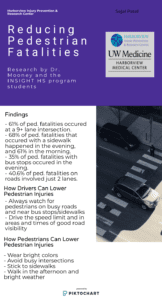
2022 Update:
The study titled, Microscale pedestrian environment surrounding pedestrian injury sites in Washington state, 2015–2020, was recently published in the July 2022 Traffic Injury Prevention journal. All published authors are from HIPRC, which includes: Julian Takagi-Stewart, BS, Amy Muma, MS, OTR/L, Christina V. Umali, MPH, Michaela Nelson, Ishan Bansal, Sejal Patel, Monica S. Vavilala, MD, Stephen J. Mooney, PhD.
Originally posted September 24, 2020 and written by 2020 INSIGHT High School Alumna, Sejal Patel –
Under Harborview Injury Prevention & Research Center’s (HIPRC) INSIGHT High School Summer Research Program, a group of students and I, led by Dr. Mooney, conducted a research project to find out how to reduce Washington State’s rate of pedestrian injury and death by motor vehicles. Our group audited hundreds of intersections and road locations where pedestrian fatalities have occurred on Computer Assisted Neighborhood Visual Assessment System (CANVAS) to group together similar characteristics of each location and find out ways to eliminate common instigators of pedestrian accidents.
The participants and I found that approximately 61% of pedestrian fatalities at intersections involved 9+ lanes, and the majority of fatalities occurred in the evening and morning, indicating that likely high distraction and low visibility are the main culprits of pedestrian fatalities. With this information, all of the students presented call-to-actions with suggestions ranging from building more streetlights (to increase road visibility for drivers) to implementing a mandatory pedestrian education course (for prospective drivers to learn how to avoid pedestrians on the road) at the virtual research symposium. My cohort and I targeted our findings toward officials of licensing, transportation, law enforcement, and more to simulate voicing our findings to those in power to make a direct change.
This intensive summer program allowed for students to learn how to conduct public health research under Dr. Mooney and organize the findings into a visual component to present to HIPRC’s staff and associates, all while investigating the common causes of pedestrian fatalities in Washington, which accounted for thousands of deaths in the US each year and is only increasing.
